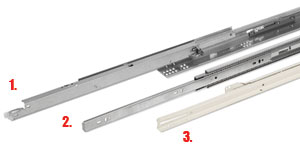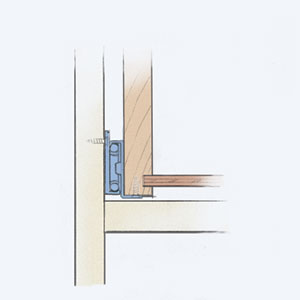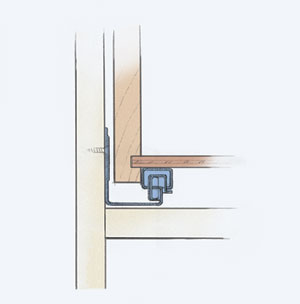What's the Difference: Drawer Slides
Once all of the factors of your drawers are weighed in, including length, content weight, and extension, you can determine the right drawer slide for your needs

Whether you’re ordering new cabinets, building them yourself, or planning to upgrade existing units, drawer slides are important. Choosing the right type of slide involves a number of factors. The length of the drawer, the weight of its contents, and the option of having full-extension or half-extension drawers are important considerations. You also may need to know whether the slides can be used with face-frame or frameless cabinets. If you’re making drawers for a cabinet, choose the slides first because they determine the finished width of the drawer relative to the width of the opening.
Epoxy-coated utility slides, also called Euro slides, are versatile and relatively inexpensive. Commonly available at home centers, these slides rely on a single plastic roller ball in each member of the slide and are typically half-extension. That means you won’t have easy access to stuff in the back quarter of the drawer. The most common Euro slides are designed so that the moving parts of the mechanism mount along the bottom corners of the drawer. These slides usually have a self-closing feature that allows the drawer to close by itself once it’s within a couple of inches of closed. They require 1⁄2 in. of space on each side of the drawer. Euro slides are economical but generally not as smooth as ball-bearing slides.
Stainless-steel ball-bearing slides come in many configurations for everything from kitchen-box drawers to office-file drawers. Many slides are for full-extension access, meaning that the entire drawer can extend out from the case, but they’re also sold in half-extension styles. You also can buy overtravel slides, which let the drawer extend beyond the opening, a convenient feature when a countertop overhangs the front of the cabinet. These slides mount similarly to Euro slides, needing 1⁄2 in. of space on each side of the drawer. Inserting and removing the drawer once installed can be fussy.
Undermount slides mount under the drawer. They’re the only slides that can’t be seen when the drawer is open, a benefit when you want to show off premium-quality drawers. Undermount slides typically operate extremely smoothly; high-end versions even feature a cushioned, self-closing mechanism.
Installing undermounts, however, is far more demanding. Drawer depth and width need to be correct, and the drawer bottom must be a certain distance above the drawer sides. The back of the drawer might need to be notched to accommodate the slide.
1. Euro slides

- Least expensive
- 2-in. length increments
- Easiest drawer insertion and removal
- Self-closing feature
- Can bind or be loose if not installed perfectly
- White and beige epoxy finish
- Half-extension most commonly available
- Cost: $6 for a pair of 22-in. slides; 75-lb. rating
2. Stainless-steel ball-bearing slides

- Moderate cost
- Smooth operating
- Most versatile all-purpose slide
- Broad range of load ratings available
- Half-extension, full-extension, and overtravel options
- Chrome finish most common, but black also available
- 2-in. length increments
- Can be difficult to insert and remove drawer
- Good tolerance for slight measurement variations
- Cost: $15 for a pair of 22-in. slides; 75-lb. rating
3. Undermount slides

- Invisible; won’t conceal drawer joinery
- Smooth operating
- Self-closing feature
- Most expensive slide hardware
- Exacting installation requirements
- 3-in. length increments
- Cost: $30 for a pair of 21-in. slides; 75-lb. rating
Tony O’Malley is a cabinetmaker who lives in Emmaus, Pa. Drawings: Dan Thornton



























View Comments
I've read a number of articles saying the balls in ball-bearing slides gum up and come apart. Is this just a problem with cheap ones? Do they need to be lubed? If so, with what?